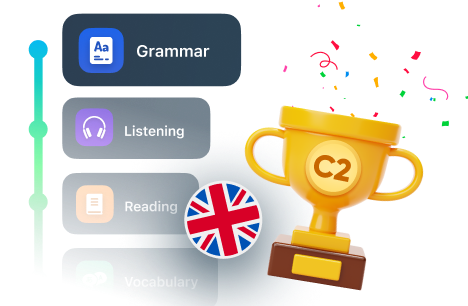
A Guide for Learning Spanish as a Beginner
Learning basic Spanish may seem tedious, but it is a fun journey that takes time, perseverance, and a lot of discipline.

Get a FREE guide!
Want to sound like a native English speaker?
Get our free PDF with top tips that work.

Check your email!
Imagine learning new Spanish words and using them in fascinating ways; admittedly, the feeling never gets old. But just as there are the high points of learning, there are also the lows that come when errors, misinterpretations, and forgetting things you thought you had mastered.
Learning basic Spanish may seem tedious, but it is a fun journey that takes time, perseverance, and a lot of discipline. You would still make mistakes, which shows growth, but your major objective must be learning in stages. No one becomes a pro in one day.
Here is a Spanish learning guide to give your learning structure and keep you on the right track.
Short history of the Spanish language
Before we get to the nitty gritty of basic Spanish, it is imperative to grasp how it has grown over the years. It is easy to accept the modern version of Spanish, but you know of its medieval form. It may not be used in day-to-day conversations anymore, but it would give an insight into how history has shaped it.
Modern-day Spanish is traced back to the Proto-Indo-European language spoken as early as 3,400 BCE by a large population from India to Europe. Spanish is deeply rooted in Vulgar Latin (a variation of Latin) from the Italic branch of the Indo-European language.
As Romans migrated across Europe, they came to settle in the Iberian Peninsula, and after centuries of interacting with the locals, they found a way to talk to each other. This birthed the Spanish language, making the origin place the Iberian Peninsula, which is now Spain, and developed from Vulgar Latin. During the 800 years of Muslim rule, the Spanish language incorporated many aspects of the Arabic language into its own. This resulted in Spanish incorporating 4,000 modern words of Arabic origin.
Fast-forward to the 11th century, the languages of the Peninsula began to mix and give rise to dialects unique to the areas; what started with a small number of people speaking quickly gained popularity and spread. The Castilian dialect became the region’s official dialect by joining the kingdoms of Castile, Aragon, and Leon in the 15th century.
Castilian Spanish is still the country’s official language in present-day Spain. However, other varieties of Spanish are also spoken all over the country and around the world.
How to start learning Spanish for beginners
The first thing you need is discipline because nothing is accomplished without it. Secondly, you would need access to good learning materials, Spanish tutors, or paid lessons on effective sites like LiveXP to take Spanish lessons for beginners. The third thing you would need is lots and lots of practice.
Guide to learning Spanish: What to learn first in Spanish
Start with learning basic Spanish
You should note that this is not a rigid guide; you may start learning the way you want. This guide has been carefully put together to focus on the easier aspects first and slowly advance to more difficult levels. Take your time at each level until you have confidently mastered the basics, and build from there up. Remember, learning is not a competition but a chance to become a better version of yourself.
With no further ado, the following are the basics of learning Spanish as a beginner.
Learning the Spanish alphabet
It goes without saying that the most basic part of any language when you start learning is its alphabet system. There are 27 letters in Spanish, and how they sound needs to be mastered as they are the foundation for any words you wish to speak or write. Over time, you will find that the Spanish alphabet is closely similar to that of the English language. However, some letters, like “ll,” are only in Spanish but are not present in English, so pay attention to them.
There are many educational videos about the alphabet and its sounds. Children’s books can also be instrumental in learning the alphabet as they are written for easy assimilation.
Master Spanish numerals
The Spanish numbers are also very elementary parts. As you learn the alphabet, you should also learn the numbers alongside. This gives you a lot of things to learn before getting into more complex parts. Building a solid foundation in the numbers makes learning and assimilating other aspects of Spanish easier, as most of these things work hand in hand.
Learn basic Spanish words first
This is the part of your learning where you build vocabulary by learning simple words bit by bit. With simple tenses, everyday words, and phrases, you can bring all of them together when the time comes to construct full-fledged sentences.
The best way to start this is with two, three, and four-lettered words in Spanish. You can proceed to basic greetings, time telling, days of the week, and months of the year. It would also be good to learn colors, common household items, daily routines, fruits, animals, body parts, etc. Duoling can help you build basic vocabulary and teach you how to form simple sentences.
These words and phrases create the very fiber of Spanish, so first mastering them will help improve proficiency. To achieve that, LiveXP has the Word Trainer feature to help you learn the vocabulary using a steady but spaced repetition method to memorize it effectively. LiveXP can be accessed from any mobile, desktop, or tablet device, so you can learn anytime at your comfort and pace.
Take Spanish lessons for beginners to start learning grammar
Learn the verb and verb placement
It’s time for an upgrade from single words to start forming short sentences. Even if you go to a tutor for help in learning basic Spanish grammar, it’s good to know what topics should be covered to progress step by step to more advanced topics.
Verbs are important in any language, with Spanish not being an exception. Verbs are words used to describe actions, states, or occurrences, forming the main part. Without verbs in a sentence, they would appear incomplete and meaningless.
The two major verbs in Spanish are “ser” and “estar.” These verbs mean “to be”; they are used in dynamic ways and scenarios. Ser is an irregular verb with pronouns like I, you, they, them, etc., and it is conjugated accordingly. It is also used to describe how a person looks or a personality trait and personal relationships between two or more people.
There are other “ser” uses, and you can learn them all from your Spanish tutor on LiveXP. LiveXP provides 1 on 1 teaching sessions with experienced Spanish tutors so you can learn how these verbs work and the case scenarios in which they may need or may not be changed.
“Estar” is also an irregular verb used to express a status or condition that would probably change in the future. It is used to show different forms of emotions like happiness, sadness, or anger. It is also used to tell a person’s marital status and location. Once mastered, forming sentences becomes a breeze; you may find the conjugations tricky at first, but with practice and help from LiveXP, it will become seamless.
Gender rules and plurals
Nouns in Spanish are either masculine or feminine, guiding the structure of both spoken and written sentences. Certain rules should be observed when using the gender forms of nouns to avoid miscommunication, and these rules apply to both animate and inanimate objects.
One other thing to note is that most languages have a neutral gender, but that is not applicable in Spanish. That’s why learners whose native language doesn’t have gender forms struggle with these Spanish basics. It is natural to look for help when it’s difficult for you to understand. Take private lessons from a Spanish tutor on LiveXP to cover complex topics fully and never mix things up.
The gender rules are as follows;
- Singular masculine nouns are to start with el e.g. el hombre
- Plural masculine nouns start with los e.g. los hombres
- Singular feminine nouns start with la e.g. la ballerina
- Plural feminine nouns start with las e.g. las ballerinas
However, most nouns ending in –o are masculine, e.g. libro (book), while those ending in –a are feminine, e.g. taza (cup.) There are, of course, exceptions to this rule, like in the case of hombre (man).
Feminine nouns can also end with –dad, -tad, -ia, -cion, -sion, -umbre, -dora. E.g. la canción (the song), la gracia (the grace), la solidaridad (the solidarity).
The masculine nouns end with -n, -r, -l, -y, -s, -x E.g. el corazón, el amor, el bus, un tórax, un buey
Learn personal pronouns
Personal pronouns are used to replace the subject (name or noun) and are essential to conjugating the verbs in the sentence or phrase. These personal pronouns are:
- I (yo)
- You (tu)
- He (el)
- She (ella)
- You (usted)
- We (nostrous / nosotras)
- You (vostrous / vosotras)
- Them (ellos / ellas)
- You (usetedes)
Using these pronouns depends on the message the sentence is trying to pass and so it must be conjugated accordingly. Wrong conjugations would cause miscommunication, but with practice you would be able to master the rules and makes less mistakes overtime.
Master basic Spanish tenses: present, past, and continuous
There are five important verb tenses to explore during your study: time, mode, number, person, and aspect. Just like in English, these tenses are used to show the time in the present, past, or future in which an action takes place.
The present tense shows what the subject is currently doing or usually does.
e.g.
(I am going to the beach) – voy a la playa
The past tense shows what the subject has done or events that have occurred. It is mostly used to check on time like last year, yesterday, last month, etc.
e.g.
(Ayer cené en casa de mi amigo) – I had dinner at my friends’ house yesterday
Future tense is used to portray actions that are yet to occur,, such as plans for the next week or month. It is common to use future tense like next week, next year, or next hour.
e.g.
(La familia viajará mañana) – the whole family will be travelling tomorrow.
This grammar topic is a more complex one, and it can be difficult to master on your own. In terms of basic Spanish grammar, it is best to master it at the beginning with your Spanish tutor. It happens when a learner tries to save some money and learn grammar from free resources on their own. It leads to basic mistakes, improper grammar use, etc. It’s much harder to re-learn this stuff than to learn it right from scratch. So, go to https://livexp.com/skills/spanish and choose your Spanish language tutor to master grammar skills.
Practice Spanish commands
The Spanish commands are also known as imperatives and are verb forms used to address someone directly or give an order to be carried out. Due to the nature of instructing another person, Spanish commands are usually in the familiar second-person form—tu, and vosotros.
Spanish commands require that the sentence’s verb has different conjugations depending on these three factors. Whether the verb is:
- Formal or informal
- Negative (to not do something) or affirmative (to do something)
- Singular (where the order is given to one person) or plural (the order is given to two or more persons)
Formal commands are used to be polite or respectful to the person being addressed. They are mostly used for elders, bosses, or anyone of higher ranks in an official or formal setting. They are formed using the third person form—usted of the present subjunctive. Informal commands are used for people the speaker is more familiar with, like family members and friends, and mostly use tu.
The affirmative deals with the conjugation of both regular and irregular verb forms. The regular verbs have the same form as el, ella, and usted in the present tense, while the irregular verbs have an irregular form and are mostly one-syllable.
Want more Spanish basics for beginners? On LiveXP, you can learn Spanish with different tutors to ensure you get the best education. With a subscription, LiveXP allows you to have lessons with a tutor who speaks your native language and practice with a native speaker.
Conclusion on how to master Spanish basics for beginners
Speaking fluently in a second language is a big communication flex and because Spanish is not an underrated tongue, learning it becomes even more precious. The advantages of a second language are numerous, going from academic and career opportunities to erasing language barriers and promoting culture, so it should be taken seriously.
We have come to the close of this guide to learning Spanish, but before we do, an emphasis on practice is due. As much as the areas in this blog are the basics, they won’t do much to your proficiency in Spanish if they are not practiced repeatedly to the point of mastery.
We understand that you would need help on your road to learning Spanish, which is what LiveXP seeks to provide you with.


















